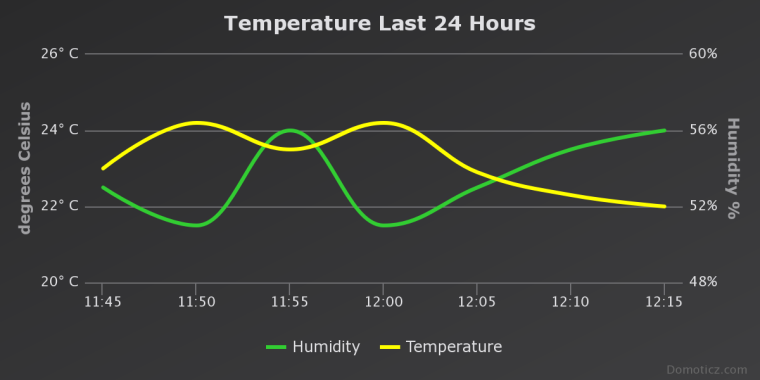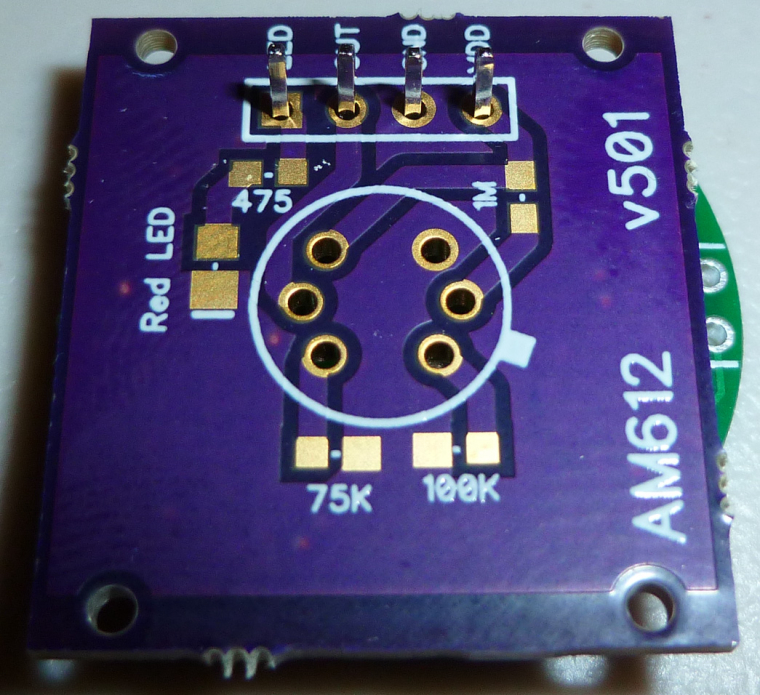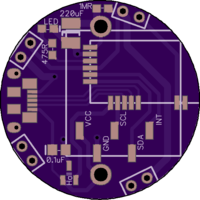💬 Multi-Sensor: Temp/Humidity/PIR/ Leak/Magnet/Light/Accel
-
Nice project!
What about adding two resistors to measure and send the battery level as well?
@krisha said in 💬 Small Wireless Temp/Humidity Leak/Magnet/Light/Accel Sensor:
What about adding two resistors to measure and send the battery level as well?
not needed. You can measure the battery voltage without a divider.
-
Now reads temperature and humidity from the si7021 and sends the values to Domoticz for graphing:

-
@ghiglie said in 💬 Multi-Sensor: Temp/Humidity Leak/Magnet/Light/Accel:
...another n00b question: what are the PCB dimensions?
The diameter is 27.15mm.
-
@ghiglie said in 💬 Multi-Sensor: Temp/Humidity Leak/Magnet/Light/Accel:
...another n00b question: what are the PCB dimensions?
The diameter is 27.15mm.
-
@NeverDie Thanks! I'll ask the fab if they can do it without charging extra costs. Or I'll "square" it - maybe with a hole in the angles to screw it. Really like this design.
-
@ghiglie What is it that you'd want to screw it to? It might be easier to just tape it or glue it in place. It's light enough that it wouldn't need much holding strength. Screwing may be overkill.
@NeverDie said in 💬 Multi-Sensor: Temp/Humidity Leak/Magnet/Light/Accel:
@ghiglie What is it that you'd want to screw it to? It might be easier to just tape it or glue it in place. It's light enough that it wouldn't need much holding strength. Screwing may be overkill.
I was thinking about the top of a door... You'r right, I overestimated its weight.
-
@NeverDie said in 💬 Multi-Sensor: Temp/Humidity Leak/Magnet/Light/Accel:
@ghiglie What is it that you'd want to screw it to? It might be easier to just tape it or glue it in place. It's light enough that it wouldn't need much holding strength. Screwing may be overkill.
I was thinking about the top of a door... You'r right, I overestimated its weight.
@ghiglie said in 💬 Multi-Sensor: Temp/Humidity Leak/Magnet/Light/Accel:
@NeverDie said in 💬 Multi-Sensor: Temp/Humidity Leak/Magnet/Light/Accel:
@ghiglie What is it that you'd want to screw it to? It might be easier to just tape it or glue it in place. It's light enough that it wouldn't need much holding strength. Screwing may be overkill.
I was thinking about the top of a door... You'r right, I overestimated its weight.
If you've never tried them, these things are great:
https://www.amazon.com/Command-Poster-Hanging-60-Pairs-17024-60ES/dp/B01FIK56Q4/ref=sr_1_3?ie=UTF8&qid=1510769859&sr=8-3&keywords=3m%2Bcommand%2Bmounting&th=1
They have a lot of holding power (more than ample for one of these sensors), and yet they can be cleanly removed without damaging the surface you hang it on.3M also has a velcro-like version so that you can attach, then detach and re-attach as much as you want.
-
First, the good news: it works! :) I've uploaded photos of the version 7 board that I just today received and put together. It powered up without a hitch and started sending temperature and humidity values to Domoticz like a champ. The one caveat is that I will need to increase the board diameter by a couple of millimeters, as there presently just isn't enough proper physical separation between the supportive male leak detection pins and the CR2032 battery holder. So, I will do that, and I will post a version 9 after I have received and tested the improved boards.
-
@ghiglie said in 💬 Multi-Sensor: Temp/Humidity Leak/Magnet/Light/Accel:
@NeverDie said in 💬 Multi-Sensor: Temp/Humidity Leak/Magnet/Light/Accel:
@ghiglie What is it that you'd want to screw it to? It might be easier to just tape it or glue it in place. It's light enough that it wouldn't need much holding strength. Screwing may be overkill.
I was thinking about the top of a door... You'r right, I overestimated its weight.
If you've never tried them, these things are great:
https://www.amazon.com/Command-Poster-Hanging-60-Pairs-17024-60ES/dp/B01FIK56Q4/ref=sr_1_3?ie=UTF8&qid=1510769859&sr=8-3&keywords=3m%2Bcommand%2Bmounting&th=1
They have a lot of holding power (more than ample for one of these sensors), and yet they can be cleanly removed without damaging the surface you hang it on.3M also has a velcro-like version so that you can attach, then detach and re-attach as much as you want.
-
I have uploaded version 9. This should fix the physical clearance issue. Also, I upgraded the cap to be a 1206 220uF ceramic capacitor, as the cost is nearly the same as for an 0805 100uF capacitor. I should think that 220uF will offer plenty of reserve for the future when the battery ultimately develops a high internal resistance.
-
More good news: I today received the PCB for a revision of my PIR module that's meant to be compatible with this Multi-Sensor. I just now did a dry-fitting, and, indeed, it should all fit together just fine:

That means the entire PIR sensor can be quite small and compact! :) -
For PIR capability, the multi-sensor can simply plug into this PIR module: https://www.openhardware.io/view/420/AM612-Passive-Infrared-Sensor-Breakout-Board
-
I have an experimental version in the works which uses a micro USB connector instead of the 10-pin connector. The advantage is that it can be connected from the side rather than above, which means the PIR sensor can be snuggled up close to the rest of the Multi-Sensor PCB and then permanently soldered into place:

The result would be an even more compact PIR sensor.Once there's an OTA bootloader, though, this issue will become moot, and so I think for most people the 10-pin solution will be easier, especially for noobs.
-
@nca78 Which do you think would be the best accelerometer to use? If affixed to a garbage can, for instance, it should be able to detect the trash can being emptied by the garbage truck.
@NeverDie said in 💬 Multi-Sensor: Temp/Humidity/PIR/ Leak/Magnet/Light/Accel:
@nca78 Which do you think would be the best accelerometer to use? If affixed to a garbage can, for instance, it should be able to detect the trash can being emptied by the garbage truck.
That's a very tough question :D
For low power the best is ADXL362 but it can only be controlled using SPI which is a problem for that specific NRF51 module. And it's not that convenient as low power comes with limited "advanced" capabilities that would be useful for this kind of sensor: tap/double tap detection, free fall detection, ...I'm making a board with the same nrf51 module and my choice is LIS3DE because it has those advanced functions and can go as low as 2uA, it's very cheap (<1$) and it's small, but I'm only using the chip and not a breakout board. There are LIS3DH breakout boards on AliExpress, it's similar but the boards are big as they map all pins in a row. Only board with less pin is nearly as expensive as some NRF51 + LIS3DE combo so it's not worth buying the breakout.
I will make a version with a LSM303AGR too, it has accelerometer + magnetometer. Magnetometer is power hungry but you can use it only when accelerometer detects some movement, so you know the orientation of the sensor. That way you could easily know the difference between your garbage can being moved around, and it being turned over in the garbage truck. But here again bad news in term of breakout boards, the LSM303 breakout boards available are not the -AGR version, and I'm not sure they can run the accelerometer in a real low power way (LSM303AGR is 3.7uA in lowest power accelerator mode).
There are also some Bosh accelerometer but using more current (6.5uA for BMA255 for example) and same problems with the breakout boards: they are huge.
Sorry, no good answer to your question as there's no compact, low power, i2c compatible breakout board that I know about. If you want to use a breakout board my advice is to go for ADXL362, and if you're out of pins with this nrf51 module you can hardwire the chip select pin to save one.
-
I guess it's the land of compromise. By default I'm going with the BMA220, if only because the board is small and the low power mode current drain is 10ua: https://www.aliexpress.com/store/product/DFRobot-BMA220-3-Axis-Triple-Axis-Accelerometer-sensor-2-0-3-6V-I2C-Interface-Tiny-size/1681007_32791058717.html
It's not cheap, but I only need a couple: one for trash can and the other for a curbside recycling bin.You're right though: maybe all I need is some kind of tilt detector, like maybe a mercury switch of some kind. Perhaps that would be cheaper, and the current drain could be almost nothing.... Thanks!
